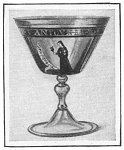
Up: Glassmaking

Glass & Glass-Making
9 of 28
|
|

| |

FRENCH ENAMELED GOBLET
Henry II period (1333-1379)
This was called a marriage cup.
The lady has a heart in her
hand. On the opposite side is
a gentlemen in the costume of
Henry II's reign, offering a
flower to the lady.
|
Bohemian Glass
Bohemian glass is a "forest glass" that dates from
the sixteenth century, when the
Emperor Rudolph II
brought Italian engravers of rock-crystal to take charge of the glass-works
he had established in Prague to imitate rock-crystal. Up
to about 1590 the Bohemians had copied Venetian models, which they decorated
with colored enamels. After they began to cut glass, they needed heavier
and thicker forms. The first Bohemian glass was white, was cut in facets and
engraved with pictures, coats-of-arms and emblems. At a later period colored
glass was made.
The famous "ruby glass" was
brought to perfection by Johann Kunckel, A
Silesian chemist, employed at the Brandenburg glass-works at Potsdam.

VENETIAN GLASS VASE
In the Metro. Museum
|
It was said that Kunckel obtained his fine ruby by the use of gold. The
shapes of his pieces-- ewers, beakers and large covered cups-- are simple.
He also made a glass of deep emerald tint.
By 1730, Bohemian glass had completely supplanted
Murano. It enjoyed enormous popularity for about fifty years, until it was,
in its turn, driven out of fashion by the English flint glass.
German Glass
While the Venetians were perfecting their
"cristallo," the Germans of the Rhine district were developing their
ancient "green glass." Rhenish glass varies from greenish blue to pale
bottle green, and from dark violet blue to olive green. It is never
decorated, nor engraved. "Prunts" are its characteristic
ornaments. These knobby projections on the stem are shaped like thorns,
mulberries, or grapes.
The typical production is the
roemer. This has a tulip-shaped bowl, a hollow
cylindrical stem studded with mulberry "prunts," and a hollow, conical
foot formed by coiling a rope of glass around a core of wood. The metal
is thick and heavy and full of bubbles and defects. The great cylindrical
glasses, sometimes twenty inches high, ornamented with paintings, are
called salutation glasses. The tall
funnel-shaped glasses and the "cabbage-stalk"
glasses are all classed under the name "brimmers."
Glass in the Low Countries
The museums of Holland and Belgium contain
enormous collections of splendid native work. Huge glasses, with bowls
shaped like tulips and
|
|